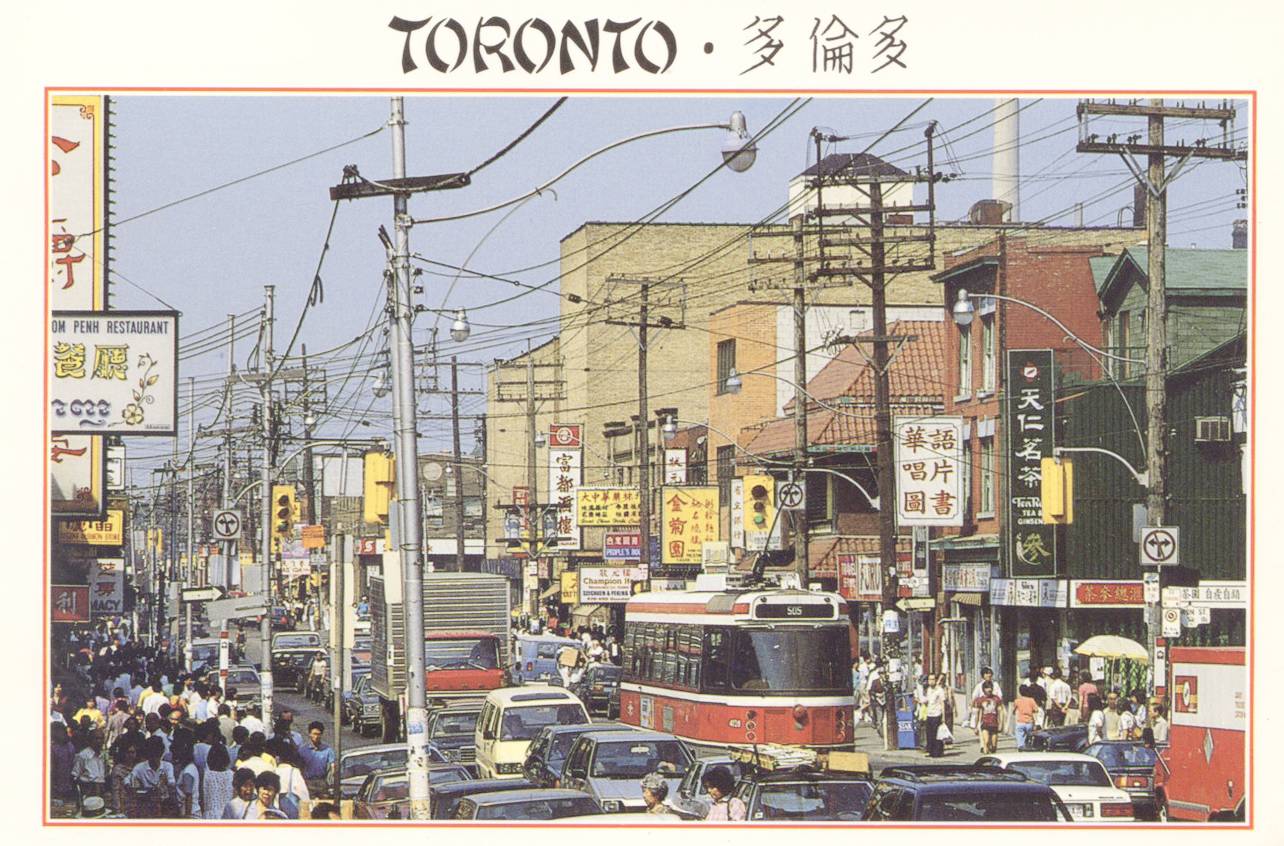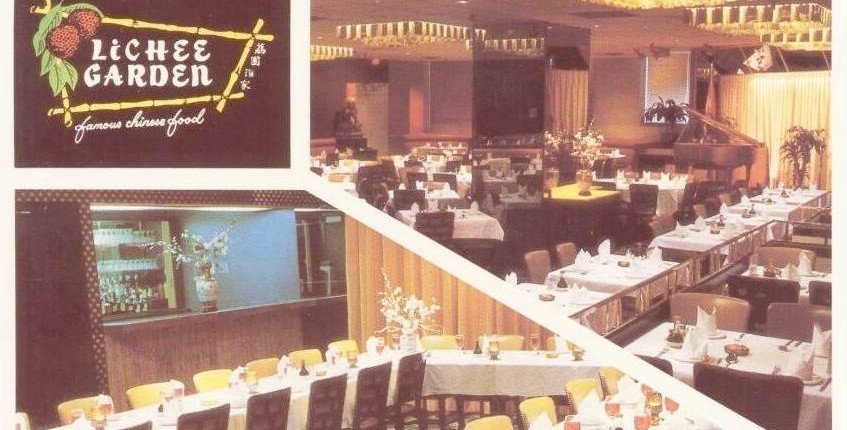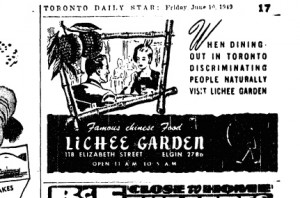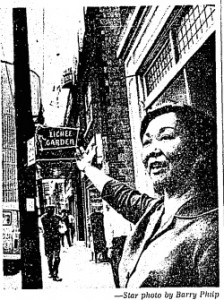Toronto’s Old Chinatown: Restaurants / Lichee Garden
Restaurants in Toronto’s Chinatown: A Brief History
Why Open A Restaurant?
As downtown Toronto was (and still is) such a dense population of people, restaurants became an alternate business endeavour to laundries, where many Chinese people decided to meet the growing demand for cheap food. It wasn’t until around 1910 that the Chinese restaurant business started to pick up, with a large increase in establishments happening between the late 1910s and early 1920s.
Opening A Restaurant
Restaurants became a popular business endeavour for Chinese people living in Toronto; the startup was fairly easy in the sense that people without much experience could learn the work as they went. While the startup price was significantly higher than opening a laundry at roughly $1000 – $2000, the profit margin was larger. Chinese people could borrow their startup money, as well as enter into partnerships with others in order to open a restaurant.
Owning A Restaurant
In order to limit personal expenses and maximize profits, Chinese restaurant owners lived on the premises, usually in a small apartment above. Owners would also prominently hire family members to work in the restaurant in jobs such as waiters or chefs, keeping the restaurant within the family. Problems were ran into when Chinese restaurant owners would hire outside their family, particularly with the hiring of white waitresses.
Restaurants Inside and Outside Toronto’s Chinatown
Chinese restaurants were not only opened within Toronto’s Chinatown, but many were opened outside. They quickly became popular as they offered a substantial amount of food for a low price. These restaurants, while operated by Chinese persons, served Western food to appeal to Canadian diners. Later, these restaurants began to adapt Chinese dishes to appeal to Canadians, such as chop suey or chow mein.
Chuckman’s Photos On WordPress: Toronto Nostalgia
Lichee Garden: The Basics
The Beginning
Lichee Garden first opened in 1948 by its first owner Harry Lem. Located at 118 Elizabeth St., where the restaurant spent the following 35 years, Lichee Garden was among the first big Chinatown restaurants in Toronto. Prior to these big establishments, Chinese restaurants in the area could only accommodate a small number of people of around 20, where Lichee Garden could accommodate roughly 300 guests at a time. The restaurant would remain open from 11am to 5am daily, and was the second restaurant in Toronto to have a liquor license.
The Establishment
What started off as a place for Chinese clientele became a popular attraction for non-Chinese people as well, with roughly 80% of its customers being non-Chinese. Lichee Garden staffed roughly 100 people at a time, including waiters, cooks, and cleaners. On a busy day, it was not uncommon for 3000 guests to dine there, with long waits for a table at dinner time.
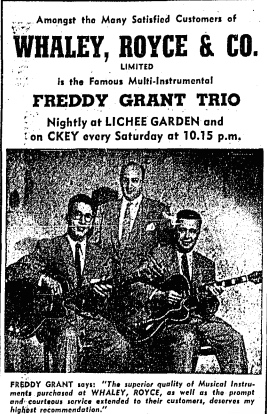
The Toronto Daily Star
The Environment
Harry Lem’s goal was to serve Eastern foods in the largest and finest environment in Chinatown. The same band played for 20 years, providing guests with live music. It provided guests with a very unique dining experience. Many customers became interested in China and its culture after dining at Lichee Garden and turned to Harry Lem for information, which led him to venture into becoming a travel agent.
Who Was Harry Lem?
“Never wait untill you are thirsty to build a well.”
Born “Lem Fong” in Hong Kong, Harry Lem came to Canada in 1918 as a boy of 12 years. He came to Canada to meet his father in Toronto, and went to school for only a year and a half before beginning his first job at a Chinese laundry. At 18 he became a waiter at a Chinese restaurant, where the beginning of his work with restaurants essentially begun. At this point, he made $12 a week, working roughly 18 hours a day.
When his father returned from a brief leave due to illness, the duo took over a small cafe in Milton which became a success, encouraging them to take over various other cafes and small restaurants in Ontario before Harry Lem finally moved to Toronto’s Chinatown.
His first job in Chinatown was at The International Chop Suey House, where he worked for 10 years in collaboration with 10 other men. Unfortunately, he could not take over the restaurant as he had wanted to do, which led to his purchasing of a lot on 118 Elizabeth St., the only vacant lot at the time. He began building Lichee Garden with a couple friends, taking 4 years to complete it. His goal was to create the largest and finest restaurant in Chinatown.
Quickly becoming popular, he bought the lot behind it to expand the kitchen of the restaurant, as well as the store below. As he was importing such an enormous amount of food from China, he decided to enter the importing business, and in 1957, he was the largest importer of Chinese food in Canada. His list of jobs continued to grow; so many of his customers were interested in China, so he decided to also become a travel agent. Due to his involvement with so many different areas, he received a ton of mail, thus deciding to open his own post office, he made his community’s postmaster.
Lichee Garden: Advertisements
An advertisement for Lichee Garden from The Toronto Daily Star on August 30th, 1948. It states, “Thousands who have visited Lichee Garden have acclaimed it for its fine Chinese dishes prepared under the direction of master chefs. You’ll thoroughly enjoy relaxing, Oriental atmosphere, so don’t fail to visit Lichee Garden before you leave.” In this particular advertisement, the food is the main focus being used to draw in customers. In particular, the ad appears to be more for tourists, as it states “before you leave.” An authentic atmosphere is trying to be portrayed, as even the woman in the corner appears to be dressed in traditional Chinese clothing.
Another advertisement for Lichee Garden from The Toronto Daily Star on June 10th, 1949. This one ran roughly a year after the previous one, and already radical differences can be spotted. It states, “when dining out in Toronto, discriminating people naturally visit Lichee Garden.” Instead of the restaurant being the focus, more attention is payed to the customers, or type of customers the restaurant was trying to attract. The people in the ad instead appear white, in popular Western dress as opposed to a traditional Chinese look. This could represent the shift in customers that Lichee Garden experienced, as being one of the first big Chinese restaurants to have a majority of Canadian customers.
New City Hall’s Impact on Chinatown Restaurants
New City Hall
The opening of new City Hall in 1965 did not only pose threats to the land that the building was taking over, many Torontonians wanted the surrounding areas, particularly Elizabeth St., to be redeveloped to fit in with the new look of the city. This pushed the Chinese community to band together in attempt to save Chinatown.
Lichee Garden
Chinatown Committees
The Chinatown Redevelopment Committee
The City of Toronto refused to finance any redevelopment that would keep the area Chinese, so Harry Lem, along with other Chinese people living in Toronto, got support from Chinese business people outside of the city to help finance a plan to preserve Chinatown. The goal of the Chinatown Redevelopment Committee, of which Lem was the chairman, was to redevelop Chinatown to fit in with the new, modern City Hall.
The Save Chinatown Committee
A number of Chinese organizations were brought together to form this committee, of which Harry Lem was also a part of. They begged for the stop of further redevelopment that would prevent the preservation of their culture, arguing that not only was Chinatown a place for Chinese immigrants to find support, but also a prime tourist spot in the city.
Author’s Notes
Kaitlyn Fralick is in her second year of study in the English program at Ryerson University. This project was created for the ENG390: Open Topics in Experiential Learning course, where the topic of Toronto’s Chinatown was provided. The topic of Chinatown restaurants was chosen after guest lectures from both Valerie Mah and Arlene Chan, who both inspired interest concerning the subject. She would like to personally thank Professor Anne-Marie Lee-Loy for her guidance over the course of this project, as well as Val Lem and Arlene Chan for their research aid through their resources.
Works Cited
“Archived – The Early Chinese Canadians 1858-1947.” Library and Archives Canada. Library and Archives Canada, n.d. Web. 24 Feb. 2015.
“As Good as the Exhibition Itself.” Toronto Daily Star (1900-1971) 30 Aug. 1948: 11. ProQuest. Web. 7 Apr. 2015.
Chan, Arlene. The Chinese in Toronto from 1878: From outside to inside the circle. Toronto: Dundurn, 2011. Print.
“Chinese Start Drive to Save Chinatown.” Toronto Daily Star (1900-1971) 30 Aug. 1967: C23. ProQuest. Web. 7 Apr. 2015.
“Granddad’s Advice to Make Friends Worked for Harry.” Toronto Daily Star (1900-1971) 6 July 1957: 13. ProQuest. Web. 7 Apr. 2015.
Postcard for Lichee Garden restaurant at 118 Elizabeth Street location. Comp. John Chuckman. Photograph. Chuckman’s Photos on WordPress. WordPress, 12 July 2010. Web. 7 Apr. 2015.
Postcard for Lichee Garden restaurant at 118 Elizabeth Street location from the 1960s. Comp. John Chuckman. Photograph. Chuckman’s Photos on WordPress. WordPress, 26 Sept. 2013. Web. 7 Apr. 2015.
Postcard for Toronto’s Chinatown. 1980. Comp. John Chuckman. Photograph. Chuckman’s Photos on WordPress. WordPress, 2 May 2013. Web. 7 Apr. 2015.
Postcard of Toronto’s new City Hall. 1966. Comp. John Chuckman. Photograph. Chuckman’s Photos on WordPress. WordPress, 8 Oct. 2012. Web. 7 Apr. 2015.
“Whaley, Royce & Co.” Toronto Daily Star (1900-1971) 3 Dec. 1954: 40. ProQuest. Web. 7 Apr. 2015.
“When Dining Out in Toronto Discrimination People Naturally Visit Lichee Garden.” Toronto Daily Star (1900-1971) 10 June 1949: 17. ProQuest. Web. 7 Apr. 2015.

